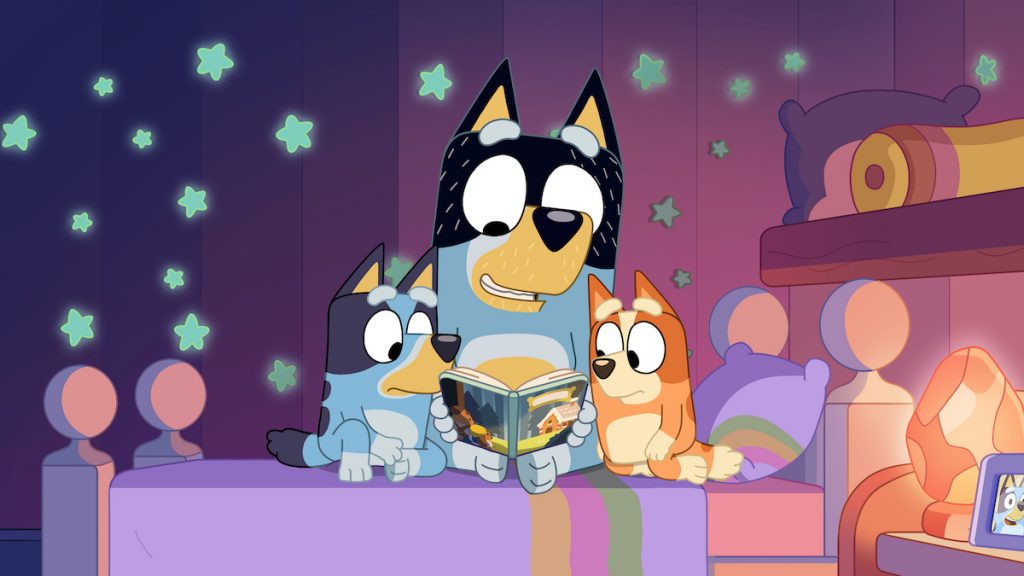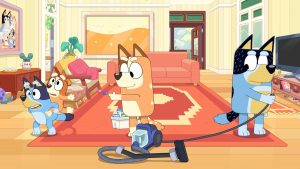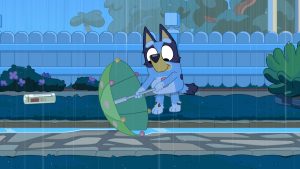
After more than 35 years of operation, TBI is closing its doors and our website will no longer be updated daily. Thank you for all of your support.
TBI Kids: How ‘Bluey’ became the top dog of co-viewing
Australian pre-school series Bluey has taken the world by storm over the past few years. Mark Layton talks to the show’s creator, Joe Brumm, about what makes the animation such a co-viewing hit
Since its launch on ABC Kids in 2018, Australian pre-school animation Bluey has quickly struck a chord with children and parents alike around the world.
Produced by Ludo Studio in Brisbane, distributed by BBC Studios, and streaming far and wide thanks to acquisition deals with outfits including Disney+, the comical day-to-day adventures of cattle dog family the Heelers – Bluey, her sister Bingo, dad Bandit and mum Chilli – are now watched in more than 60 countries.
The show’s global success rests in no small part in that it has become a co-viewing hit, with each seven-minute episode dedicated to Bluey and Bingo’s imaginative playtime – and their parents’ spirited efforts to join in.
Show creator Joe Brumm remains modest about Bluey’s growing success and his role in it, telling TBI: “To be honest, I just write them to make me laugh, and what I think will make kids laugh. And for the most part it does.
“I think you laugh a lot when you’ve got a kid; there’s a lot of shared laughter in my house, so it just seemed natural to try to capture that in the show.”
Digging into what has made the programme such a popular co-viewing experience, Brumm adds: “The world that is being shown on Bluey a lot of the time is the world of the kids’ recreation, so it’s easy to co-view because a kid enjoys watching another kid re-enact a library or a cafe – we rarely go to the places, we usually show it being re-enacted. And the parents enjoy seeing the little bits where they get it wrong, I guess the slightly bizarre nature of it.”
Keeping it real
Brumm describes what happens on the show as “like 90%” based on experiences he has had raising his own children.
“The games are ones the kids have made-up, the sort of play that I observed my kids doing. At that age, between four and six, they’re recreating the world around them but they miss out on so many details, so many small little things, so that it ends up a really bizarre world.
“That’s what I loved – witnessing this bizarre version of our reality and I thought that would be quite fun both for kids and adults to animate. That’s what a lot of adults get out of it and kids just love seeing other kids recreate the world, because that’s what they do.”
Emerging as a breakout character from the series is Bandit, Bluey’s dad, who has grown into something of an international parenting icon for his (often begrudging) willingness to drop everything and join in with Bluey and Bingo’s games.
Brumm describes the mounting reverence for his cartoon creation’s parenting skills as “pretty weird” – understandable given the slightly autobiographical element of the series – but adds: “Bandit has got his faults. I like to think he’s sharp, he gets a lot of shit for being perfect but he’s always pretty tired, he doesn’t play particularly willingly. I can’t live up to Bandit; I’m probably more like Uncle Stripe instead. I played a lot with my kids, I was lucky enough to be working from home so I could do it and so that’s just going to come out in Bandit.”
But, Brumm adds: “If it gives a little bit of a guide to someone for how to play with a kid who might not be used to it, then I think that’s a job well done.”
Sticking to the rules
Establishing the right tone of the father-daughter relationship was one of the major factors in getting the show picked up, says Brumm, who reveals that Bandit wasn’t always such an attentive dad in his earliest iteration.
“Charlie [Aspinwall] and Daley [Pearson] from Ludo had a little mini pilot for a good year, taking it to MIPCOM and different places.
“The little one-minute short I’d made had Bandit pushing Bluey all the way around on a swing, while he’s playing Fruit Ninja on his phone,” explains Brumm. The short “stuck in people’s memory,” but they were unwilling to commit to a pre-school series where “Dad’s on his phone and you’re breaking all these rules.”
After receiving funding from the ABC, a pilot was produced. “When we pitched it, it was pretty instant,” reveals Brumm. “We had most of the distributors and broadcasters, ironically except for Disney, trying to bid for it.”
Now that the tone has been set, Brumm wouldn’t change it. While Bluey and Bingo have both aged a year across the show’s three seasons, don’t expect to see them growing too much older.
“Bluey works best when it is kids of this age, 4 to 6. Above that, they start getting into a bit more abstract thought and it would become a different show. That age is about the recreation of the adult world and that’s where the richest stories are.”
As for the future of the show itself, Brumm couldn’t confirm if and when a fourth season might be coming but says that he has been working on some Bluey shorts – “just one-off things that couldn’t quite spin out into full episodes.”
The sincerest form of flattery
With its clear Australian setting and voice, Bluey would appear to be proof, if any were required, that children’s shows can be region-specific and still sell well internationally, something it shares with the show that helped to inspire it – UK pre-school series Peppa Pig.
“I just looked at Peppa Pig as it was one of the top kids shows and one of my personal favourites and my kids loved it. I’d worked with those guys, I loved their sense of humour and I loved how English it was – I felt like I recognised the people I’d met in England on that show.
“I wanted to take that ethos but do a version for me – an Australian version where an Australian could watch it and go ‘I work with that person or I know that person’. It’s the vibe of Peppa that I wanted.”
However, Brumm is sceptical that Bluey’s popularity represents any wider global trend towards localised content: “It’s succeeded despite its localism, and I think Peppa Pig was the same. I appreciated Peppa for its localism, because I was living in England, but I think each of the shows has succeeded for different reasons.
“The main reasons are that it just tells a good story and it’s funny. The ‘Australian-ism’ doesn’t hinder it – that was my worry, that the accents wouldn’t be understandable. Some people appreciate some of the little quirks, but it’s not the ‘Australian-isms’ that have made it popular.”
A well-told story
As well as Peppa Pig, Brumm’s enthusiasm for other animation remains strongly focused on the UK. He shares that he has particularly enjoyed the adaptations of Julia Donaldson and Axel Scheffler stories, such as The Highway Rat, The Gruffalo and Stick Man, from UK-based Magic Light Pictures.
“They are very calm and they’re very well directed. I find it fascinating that there’s still a place for half-hour one off [stories] in animation. I don’t understand the business model but I love that it still exists. I love the pace of those.”
It’s a place that feels all the more fragile in recent years, with current trends seeing young audiences turning increasingly towards platforms such as YouTube and short-form content for entertainment.
Brumm considers himself as “someone who likes telling stories with a beginning, a middle and an end”, but argues that there is plenty of room for animation of all lengths and complexity. “Admittedly Bluey is only seven minutes long, you could argue that’s quite short, but the shorter one minute 30-second-long clip type things, there’s a place for that. It’s so engaging, it’s so easy and quick to watch – but I hope it never replaces watching a well-told story.”
The future for kids’ animation, especially considering the current demand from streamers, is bright on the whole, believes Brumm. “There’s definitely some good quality shows coming out. Some of the stuff I see now is of quite a high visual quality.
“I don’t watch it engaged enough to know what the scripts are like, but hopefully if Bluey’s done anything, it’s shown that you can have a good co-viewing show for this age group. I hope to see more of that.”







